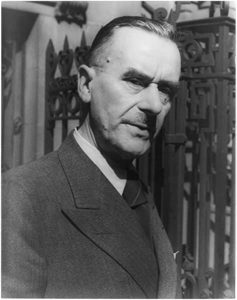Forget Visconti, Dirk Bogarde and Mahler. It’s very interesting to read what Thomas Mann actually wrote in his 1911 long short story/novella.
For me this was a return to something I read – only once, I think – long ago. Mr E was keen on Thomas Mann because he’d done German A level and become absorbed in things Germanic. Death in Venice arrived in our household with him when we married so of course I picked it up. And, rather sweetly, it’s his old Penguin (price 2/6) copy that I have revisited now, although the cellophane with which he’d covered it (no, I don’t know why either) has gone crispy and all flaked off as I handled it.
Gustave von Aschenbach is a complex character. Writer and aestheticist, he has, it seems, been suppressing urges all his life. Although it’s written in the third person the narrative is presented entirely from Aschenbach’s point of view until the final three- sentence paragraph. When years ago I described Death in Venice as being about the death of a sad, repressed homosexual (the word “gay” meant something else then) who falls in love with a boy and then dies, I was told off for crude oversimplification. Actually, that’s exactly what it is.
At one point he is described as “utterly lovesick” and the physical descriptions of Tadziu’s skin, hair, clothes and voice almost quiver with intensity. In fact the writing is often warmly sensuous: “foreign birth raised his speech to music”, “a waft of carbolic acid” “the sea, dazzling white in its morning slumber.” Aschenbach is a sick man and has been ill since the age of 35. Mann makes no secret of where this story is going. The title is unequivocal. All the protagonist’s senses are heightened by his illness which means that at last he can give rein to forbidden inner thoughts.
He and Tadziu never speak to each other although the boy eventually becomes aware of being followed – I’m afraid the word “stalked” came to this 1923 reader – and flashes the odd smile at the old man.
It is true, though, that this is more than a daring (for 1911) story about a dying man transfixed by a pretty boy and that’s what the famous 1971 film loses. It’s also a reflection on the nature of true – great, even – art. Aschenbach is famous for an epic novel on Frederick the Great at which he worked with “almost religious fervour”. There’s hint of Mr Casaubon about him. Mann gives us a lot of detail about his upbringing and career and shows us that Aschenbach’s ideas about art, have mellowed. It is the purity of Tadziu’s beauty which first assails him – like a homecoming.
I know you probably can’t help seeing Dirk Bogarde’s face every time you hear Mahler’s famous adagietto from the 5th Symphony. I certainly can’t. It is, however, well worth going back to the source material and marvelling at the power of Mann’s prose, even in translation.

Next week on Susan’s Bookshelves: Old Rage by Sheila Hancock